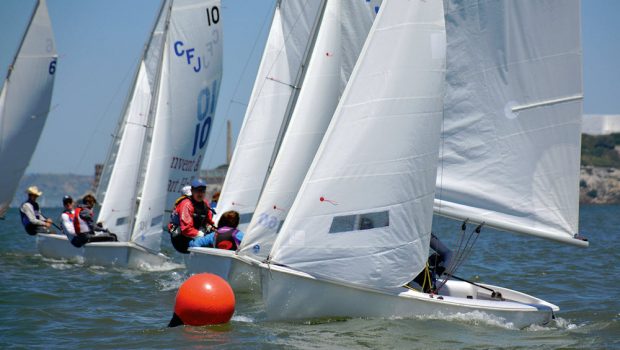Seeing the Forest through the Trees
Published on June 27th, 2017
Founded in 1927, St. Francis Yacht Club has an immensely rich history in yachting. Located alongside San Francisco Bay, few clubs have had the success in competition, and the impact in the sport, as St. Francis Yacht Club.
Their recent youth initiative is typical of this club. As most parents struggle to see the forest through the trees, the StFYC members with a better view are rebooting their junior sailing program. Head coach Adam Corpuz-Lahne describes the situation.
About eight months ago, the Junior Committee was put to task by a single question: How can we, the StFYC Junior Program, win a national championship? It turns out this was the wrong question, focusing on the regatta results of one boat.
In time, it led us to the right question: How can we encourage our junior sailors to become lifelong sailors and active members of StFYC? We believe this is the correct question to ask because it emphasizes a love of our sport and the values of our Club. It also considers all of our junior sailors, rather than the regatta results of the best junior sailor.
With this question in mind, we took a hard look at our current curriculum. We looked at the target audience for each program, the assets and staff required, and the amount of time we could allocate to each. We felt there were some programs that had reached their apogee, while others had substantial room for growth. There were some groups being served well, while others were being left behind.
Ultimately, we tasked ourselves with creating a “path” for our sailors, starting with their first Learn to Sail camp and winding all the way through High School Sailing and beyond. Thinking about this path, we identified two groups who were being underserved: our “tweenage” sailors and our dedicated junior racers (both young and old). The trick was finding the time to get these kids on the water.
In looking at our junior sailing program, it was evident that one program was occupying a disproportionate amount of our coaches’ time: High School Sailing. While our high school program has been successful over the past few years, with 60+ kids enrolled in the fall season and nearly as many in the spring season, it occupies over 90% of our head coach’s time, and 80% of our sailing director’s time during the school year.
To accommodate the seven schools that sail in the program, we run 44 days of practice per season (we can only accommodate 32 sailors per practice day), with up to 14 regatta days per season, including multiple trips to southern California. Only kids who attend our seven supported schools can participate. Some are members, but not all.
Knowing this, we decided that in order to construct a strong and sustainable path for junior sailing at StFYC, we would have to pare down our High School Sailing program. There were four ways we could accomplish this:
1) Continue supporting the seven high schools, but reduce the number of sailors allowed on each team to 4 or 5, thus reducing the number of days we dedicate to practice. The drawback is that by reducing the number of sailors at each school, we limit their ability to perpetuate their teams year to year. Schools need to be able to bring in a couple of new sailors each year, which would be difficult if their spots were limited to 4 or 5. We would also be committed to supporting 28 regatta days each year.
2) Cut some schools from the program. Again, this would reduce the number of sailors in the program, thus reducing our practice days. But cutting schools from the program would likely lead to the demise of sailing at those schools, and a reduction in the number of kids who get the chance to fall in love with sailing. And we’d still be committed to the 28 regatta days per year.
3) Eliminate High School Sailing at StFYC. This would open up all sorts of time for us to run other programs, but would terminate the relationships StFYC has built with our schools. High School Sailing is a great entry point to the sport, and many of our high school sailors have become junior members, so this was a non-starter.
4) Only support High School Sailing during one season. This would reduce our practice days and regattas by half, but not impact the number of schools we support nor the number of sailors in the high school program. It would allow Junior Sailing to offer a variety of programs in the non-high school season including to high school aged sailors. However, the sailors would not be able to compete in the full PCISA season, September through April.
After much discussion, we agreed on Option #4: support High School Sailing as it currently exists for just one season of the year. This option allows us to continue to support our schools and sailors and to bring in new sailors to the sport and to the Club while still opening up an entire season during which we can create additional programming to diversify our junior sailing path. This also mimics the calendar of all other high school sports, which run just one season a year.
Now, we had to decide which season to keep.
Of all the kids who have come through High School Sailing in the past six years, 10% possessed prior racing experience. The rest were either former summer sailing campers (at StFYC or elsewhere), or a friend of a current high school sailor who encouraged them to join. By running our High School Sailing in the fall, we can capture the momentum and interest of newer sailors that is generated during the summer.
As a bonus, the lighter winds in the fall allow for more practice days during which we are thriving rather than surviving. FJs aren’t exactly stable boats, and big winds and big waves means lots of crashes and capsizes, even for advanced sailors.
So, StFYC’s High School Sailing program will run from September through November, practicing four days a week and attending three district-wide regattas, one NorCal divisional regatta and two NorCal one-day regattas. We will utilize the remaining spring season to run other programs.
Filling the Gap: Proposed StFYC Junior Sailing Spring Programs
Race Teams (Opti and C420): Weekday and weekend practices, variable schedule. Targeted at dedicated youth racers who want to compete at regional and national level. Must be an StFYC member to join.
Intermediate C420 and Intro to Trapeze Sailing: Two weekday afternoons per week. Targeted at the “tweens” who have come through our Learn to Sail and Intro to Racing classes, as well as high schoolers looking for a greater challenge and more speed. While the goal will be to get faster every day, the focus will be on fun, with fewer drills and more adventuring. Open to members and non-members.
Keelboat Sailing (Intro and Advanced): One weekday afternoon per week. Designed to introduce kids to keelboats, teach teamwork and develop spinnaker skills. Intro-level sailors will learn seamanship and do a lot of adventure sailing, touring the Bay and seeing the sights. Advanced sailors will focus on tuning, boathandling and racing. Targeted at “tweens”, high schoolers and advanced racers. Open to members and non-members.
We believe that by creating more sailing opportunities for all our junior sailors, not just those who attend our seven schools, we will be able to “set the hook” and keep these sailors engaged in our sport and our Club. We hope our schools will support the single-season approach, as it aligns more with other high school sports seasons.
We are confident many of the high school sailors will take advantage of the new offerings and become addicted to sailing. And we are sure that more sailors, sailing a wider variety of boats, is good for our sport and our Club.
Time to Tack
by Staff Commodore Kimball Livingston
When Olympian Helena Scutt spoke to our Juniors earlier this year, she remarked that she was a more successful sailor in college, “because in my high school years I sailed a variety of boats and put time into the fast ones.”
Thank you, Helena. That’s a perfect starting point for explaining the changes we are making to youth sailing here at St. Francis Yacht Club.
In my time as Commodore I discovered that our junior coaches were way-doggies frustrated that High School Sailing—where kids race Flying Junior dinghies and represent the seven high schools that we host—consumed almost all their time.
The schedule prevented them from delivering full value to little kids in Optis, tweens, high schoolers in Club 420s or (this rang my bells) select high school-age kids with coachable talent and a passion for excellence.
Sailing is multidimensional. High School Sailing as practiced is not. It has a plus side. It brings in new people and gives the kids a vivid social experience. That’s good, so we’ll continue High School Sailing, but fall semesters only because—
Hour upon hour and year after year in the pokey high school-standard FJ dinghy does not produce a complete sailor, does not teach seamanship and (this is a two-three cocktail conversation) has not kept StFYC at the forefront of youth sailing.
On the one hand, just being on the water has value, and the boat doesn’t necessarily matter. On the other hand, take an FJ-trained youth, put her on a C-foil, trapeze-rigged, spinnaker-flying catamaran—we tried this last month—and the result is a phenomenon known in the behavioral sciences by the technical term, Totally Stoked.
The St. Francis Yacht Club cannot not be in the business of coaching excellence where the passion burns.
As Commodore 2016, I declared it a Club mission to rethink youth sailing. Junior Committee Chair Jon Paulsen asked Sailing Director Brent Harrill and Head Sailing Coach Adam Corpuz-Lahne to develop a blueprint. As Adam reports above, the process was rigorous.
Meanwhile, I reached out to other clubs around the Bay and discovered they shared our frustrations. The clubs banded together and, to the surprise of many, achieved changes to the high school sailing calendar that will encourage more diversified sailing for our kids going forward.
StFYC, however, is going even farther. Beginning with spring semester 2018, we will step away from the outside dictates of the high school calendar to focus on being a club that knows how.
Commodore Kiriakis is on board. Sailing Director Brent and Coach Adam are the architects of the new program, and Adam has done a commendable job laying out the details. Our kids deserve no less. Just sailing is nice, but Totally Stoked is where it’s at.
Editor’s note: Kimball has provided some additional insight… click here.









 We’ll keep your information safe.
We’ll keep your information safe.